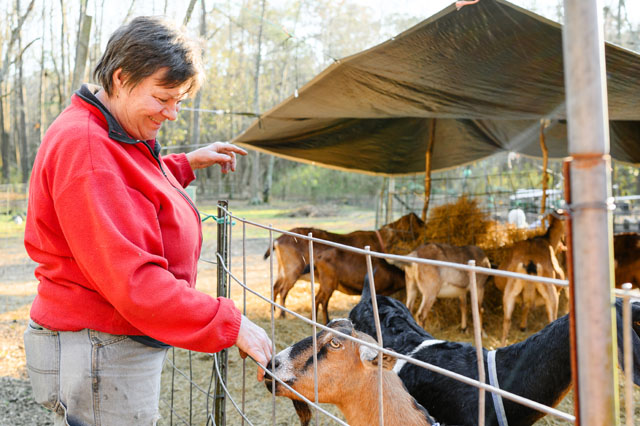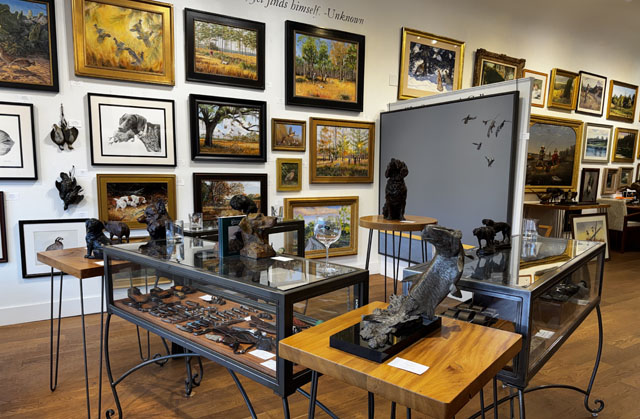‘Goat’ Milk?
05 Mar 2024
Jeremiah Farm & Goat Dairy leads the way in sustainable goat milk production
By Jenny Peterson
Photos by Priscilla Thomas

“I did not wake up one day and say, ‘I'm going to be the goat lady and I'm going to have a goat dairy,’” said Casey Price. “That wasn't it at all. I just wanted a homestead—to raise as much of our own food as we can and to have our kids have this bucolic life with their hands in the dirt.”
That desire began a whirlwind trial-by-fire foray into dairy goat milk farming, which started with one pregnant goat named Rosie (named for her reddish coat) to what is now the thriving Jeremiah Farm & Goat Dairy on Johns Island.
Today, 11 dairy goats (and their stud), a mixed breed of Nubian and Alpine goats, call the sustainable farm home. The farm is welcoming new arrivals and a fresh source of rich and creamy goat’s milk this spring.
It was Casey’s husband, Tim Price, who first suggested the family add a dairy goat to the mix on their 12-acre Johns Island property that already had chickens and gardens. Tim was no stranger to farm life, having been raised on a 110-acre farm in Virginia and—as Casey notes—he has always been an avid milk lover.
“In the year 2002, we were reading something like ‘Mother Earth news,’ one of those crunchy homesteading publications, and Tim says, ‘Did you know that a dairy goat can give you a gallon of milk a day?’” Casey recalls with a laugh. “I said, ‘Wow, that's a lot of milk,’ and he replied, ‘We should get a dairy goat.’”
Casey, who “didn’t know the first thing about goats” at the time, packed her kids in the minivan and drove to the Johns Island Library to see if there were any books about raising goats. (Casey notes that in the early aughts on Johns Island, high-speed internet and Google weren’t the norm in researching unknown topics).
At the library, there was one book available, a basic guide to raising dairy goats.
“My son was five or six years old at the time and I said, ‘I think I’ll make that part of his homeschooling,’ and we started reading a chapter a week,” Casey said. “So, as I'm reading this book to the kids and driving around Johns Island, I saw these little yellow tiny signs (on telephone poles) that read, ‘goat milk’ with a phone number.”
That kismet call—as it turned out, to longtime Johns Island dairy goat farmer Tyler Davis to get insight into dairy farming—changed the trajectory of the Prices’ life.
“I called him and I said, ‘My husband thinks we should get dairy goats. Can you help?’ And he said, ‘sure come on over,’” Casey said.
When her minivan rambled through his wooded property and parked in his driveway, Casey and her son were immediately approached by an Alpine goat named Jan, who knocked the small boy over as her way of a greeting.
Coming outside to round Jan up was Tyler Davis, a man of short stature in his 80s.
“He said, ‘let's walk and talk,’” Casey said. “He showed me where Jan lived—he had a little shed for her. He was easy to talk to and full of information. I didn’t even know what questions to ask him because I hadn’t yet finished the book!”
It was Tyler Davis who gave Casey her first sip of raw goat milk.
“I told him, ‘Don't pour me a whole glass because I may not like it,’” Casey recalls. “I held it in my mouth for a second before I swallowed it and I know I had a confused look on my face because I looked at him and said, ‘Wow, that tastes just like milk.’ And he said, ‘Well, it is milk.’
She adds, “It's so funny because that is the number one comment I get on my farm, too, although little kids say it tastes like ice cream because it’s got that sweet flavor on the top of your tongue.”
After a successful meeting with Tyler Davis and being inspired to get a dairy goat of her own, Casey looked in the South Carolina market bulletin—think Craig’s List for goats—and found a pregnant Nubian goat listed for sale in nearby Cottageville. She packed up the minivan once again with her kids and drove the hour or so to check her out.
“I had cash in my pocket and the kids and were taking a field trip to Cottageville,” Casey said. “The owner said the goat was expecting in about a month. I thought that would give us plenty of time to build a shelter because all we had was one little shed.”
The family loaded the goat—named Rosie by the kids—into the back of the minivan and headed back to Johns Island.
It turned out to be an earlier-than-expected delivery. Just two days later, the Prices had their first baby goat on the farm. Tyler Davis came over to walk them through the milking process.
“He brought his milk stand, his milk pail, his cleaning supplies and showed me what to do,” Casey said. “We walked Rosie up on his stand—there was food at the end and my kids stood on either side of her petting her and Mr. Davis showed me how to wash the udder and how to squirt the first streams out. He put the pail under there and started milking,” Casey said. The rest, as they say, is history.
Passing on knowledge
While Jeremiah Farm & Goat Dairy has humble beginnings, it has evolved into not just a raw goat milk farm, but also an informational agribusiness. Casey is a natural teacher, passing on her vast knowledge of dairy goat farm practices that she learned from Tyler Davis to visitors to the farm and anyone else curious about starting their own dairy farm. There are two other goat dairies in Charleston County.
“If we don't tap into those older farmers, then we lose out. Mr. Davis taught me all the things he knew. He became just such a friend and was more than happy to share his knowledge,” Casey said. When he passed away, the Prices inherited his goat Jan, along with his beloved mule, Earl. Thanks to Jan, the goats on the farm are now Alpine and Nubian crossbreeds.
Casey is happy to pay Tyler Davis’ knowledge and passion for the industry forward. Casey expertly explains how dairy goats generally have between two and five “kids” each year—two being the most common—and how they nurse for 8 to 16 weeks, the mother splitting the milk between her young ones and providing for the family farm to drink and sell. The goats produce way more milk than their offspring need. The mothers are milked for several months after their babies are weaned.
Some of the goats are kept on the farm for procreation and others are sold, which makes up one of the farm’s largest income sources.
While female goats are the most valuable for a dairy farm, both in providing for more milk and for selling, Casey said it’s also important to have a quality stud for breeding each year. The farm’s stud, Finn, successfully impregnated ten goats this season, all set to deliver between March and May.
Casey stagger breeds so that not all goats deliver at the same time and aims to keep a steady supply of milk available.
“I usually know within five days when babies are expected. I like to plan, and I like for the moms to have the best birthing experience with everything they need,” she said.
During the milking process, a stainless steel pail and strainer are used for milking and to filter the milk which are then put into half-gallon jugs and sold on the farm. The most boom year, the farm had 37 baby goats.
Casey said planning for the births is also important in order for the baby goats to bond with humans as soon as possible.
Friendly goats are an asset on the farm, which has visitors come by to purchase milk and soap making and cheese making classes that Casey hosts throughout the year. Casey said this year she is looking into getting a permit to sell goat cheese made on the farm.
Through May, there will be baby goat snuggle sessions with the public. Prior to the COVID pandemic, Casey hosted baby goat yoga.
Life in the pasture
Things have gotten significantly more advanced since the first baby goat was born on the farm. There are farm stands and milking machines, barn cameras, commercial grade jugs and three herd guardian dogs to protect the flock. The farm has since added pigs, a horse and farmer’s guardian dog.
Dairy goats are “retired” after ten years, and either live on the farm as pasture goats or sold to others as pets.
“We are a sustainable homestead and every animal has a job. There is no ‘free lunch’—everybody pays their way,” Casey said. “The horses give us manure, which goes to feed the plants in the garden and they also mow the pasture.”
Male goats not suitable as studs get sold as pets. Produce from the small garden is sold to the public.
“A lot of people have the mentality that a farm only means produce, but it's so much more than that,” Casey said.
She recalls bible passage Jeremiah 29:4-7 that reads in part, “Build houses and live in them; plant gardens and eat their fruit.”
“We are Jeremiah Farm after all,” Casey said.
Learn more about the farm, classes and other events at www.jeremiahfarm.com.












